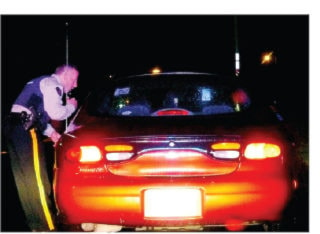Lights are flashing on one of four computer screens she’s monitoring as the phone rings and a colleague urgently asks for her advice on an important matter and the radio blurts out a request for information.
It’s a confusing, enervating stress-fest. It’s also just another day on the job for a Tammy Brown, an RCMP dispatcher at the operational command centre in Nanaimo.
“It’s interesting,” she said.
Brown made the comments at a special Citizens On Patrol (COPs) and Speedwatch appreciation luncheon in Qualicum Beach in December.
The feature speaker for the gathering, Brown used her platform to give a glimpse into what it’s like to work on the other end of the phone when someone calls the police.
Despite the confusion of sensory overload, she said it’s vital that she and her colleagues keep their cool at all times.
“We are the first point of contact between the public and the police,” she said. “We have to keep that in mind. It doesn’t matter if we’re having a bad day or if it’s caller number 900 that day ... It may be a stolen vehicle, something we see day after day after day, but to the person on the line, it’s probably the first time they’ve ever been faced with having their vehicle stolen and it’s traumatic.”
People who are traumatized in this way, she added, can be so flummoxed they can’t even provide the most basic information.
“Basic questions can throw them off,” she said.
“I’ll ask them their birthday and they can’t even answer the question because they’re so upset.
“We as dispatchers have to be aware of that. If someone has just heard a window smash downstairs or they just saw a face looking in through their window, you have to remember how traumatizing that is.”
It can be traumatizing for the dispatchers, as well, however.
“The first time I answered a 911 call solo, when my supervisor felt I was ready to fly on my own, it was an armed robbery and it was my supervisor’s daughter who was calling it in,” Brown said. “She said there’s a robbery at McDonald’s and I looked over at my trainer and said, ‘there’s a robbery at McDonald’s?’ — I’m sure my eyes were the size of my head at this point — and then she said she was so-and-so’s daughter and I said, ‘you’re so-and-so’s daughter?’ My trainer literally threw me out of the chair and took over the call.”
Other calls are less problematic.
“One time I answered 911 and it was a four-year-old child on the phone at 3:30 in the morning,” she said. “I had a conversation with her and finally convinced her to wake up mommy, who had no idea the kid was up and had been out of the house and come back in. She was absolutely mortified.”
That’s the key, she added. When you pick up that phone you just don’t know what you’re going to get.
“One time, when I was working up north, I had a gentleman call in, a bit older, extremely intoxicated,” she said. “He said perhaps the police should stop by. I asked why and he said ‘the old lady and I were having a bit of a fight and she kind of hurt me.’”
Then he hung up.
Brown dispatched a squad car, along with an ambulance, just in case. It was a good thing she did. The man’s girlfriend hadn’t just hurt him. She had plunged a large kitchen knife into his chest.
“He had put some duct tape around it and was going to try to sleep it off,” she said.
Other calls involve people hurting themselves and calling police, people seeing a bear and phoning 911, even people calling up to get the latest weather report.
Part of her job, she added, is educating people who are using the 911 line for clearly non-emergency calls.
“One time I had a guy who hit a raccoon on the road and called 911 to come and deal with it,” she said. “You just have to be ready for anything.”
